ASRock 939SLI32-eSATA2: ULi Dual x16 SLI
by Gary Key on March 2, 2006 12:15 PM EST- Posted in
- Motherboards
ASRock 939SLI32-eSATA2: Features
The system fan header is located below the ULi SATA ports. The ULi SATA ports are conveniently located below the M1697 chipset and to the left of the battery. The SATA ports feature the new "clamp and latch" design along with it being color-coded. The ULi M1697 chipset is passively cooled with a high rise heat sink that did not interfere with cards installed into the PCI slots. The TI TSB43AB22 IEEE 1394 chipset is located above the M1697 chipset.
The first physical PCI Express x16 connector is located next to the 12V power connector that must be used if two video cards are installed. The PCI Express x4 and second PCI Express x16 connectors are located next and followed by the (3) PCI slots.
We did not have any issues installing our EVGA 7800GTX 512MB or ATI X1900XTX video cards in the first and second x16 PCI Express slots. These dual slot configuration cards will physically render the PCI Express x4 and first 32-bit PCI slot useless. We did not have any issues utilizing these slots with video cards containing single slot cooling systems.
The ULI M1695 chipset is passively cooled with a large heat sink unit that did not interfere with any installed peripherals. However, this unit did not keep the M1695 chipset cooled properly. We typically witnessed temperatures hovering near 59c from this heat sink, although we did not notice any stability issues during load operations. We do believe additional cooling in this area is required.
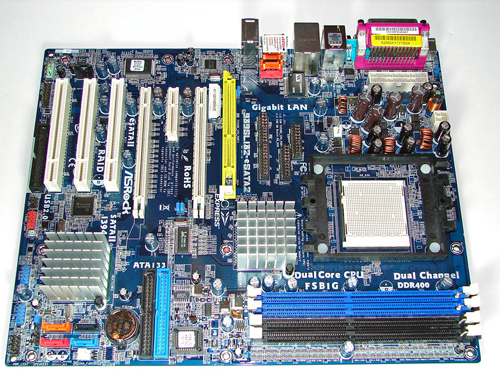
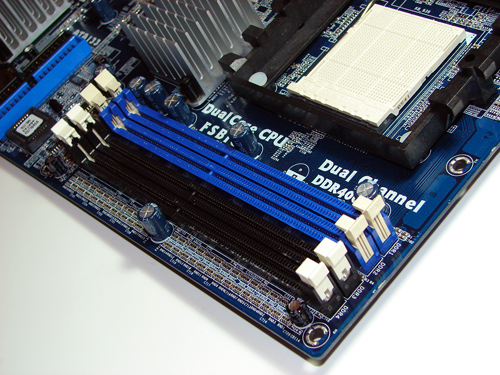

The system fan header is located below the ULi SATA ports. The ULi SATA ports are conveniently located below the M1697 chipset and to the left of the battery. The SATA ports feature the new "clamp and latch" design along with it being color-coded. The ULi M1697 chipset is passively cooled with a high rise heat sink that did not interfere with cards installed into the PCI slots. The TI TSB43AB22 IEEE 1394 chipset is located above the M1697 chipset.
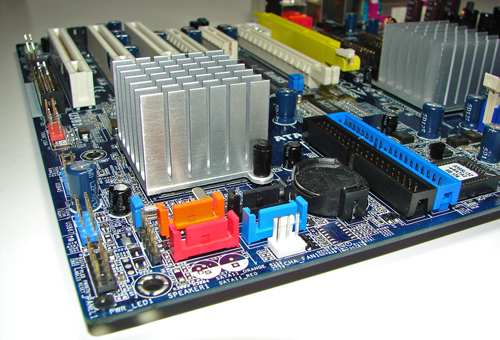
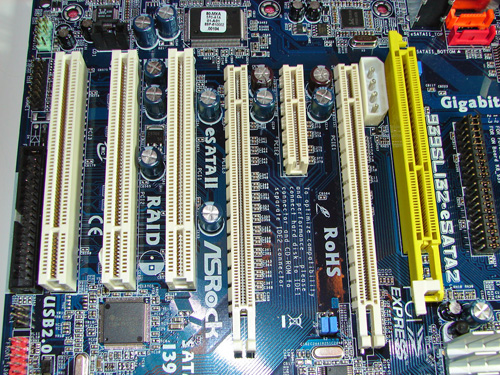
The first physical PCI Express x16 connector is located next to the 12V power connector that must be used if two video cards are installed. The PCI Express x4 and second PCI Express x16 connectors are located next and followed by the (3) PCI slots.
We did not have any issues installing our EVGA 7800GTX 512MB or ATI X1900XTX video cards in the first and second x16 PCI Express slots. These dual slot configuration cards will physically render the PCI Express x4 and first 32-bit PCI slot useless. We did not have any issues utilizing these slots with video cards containing single slot cooling systems.
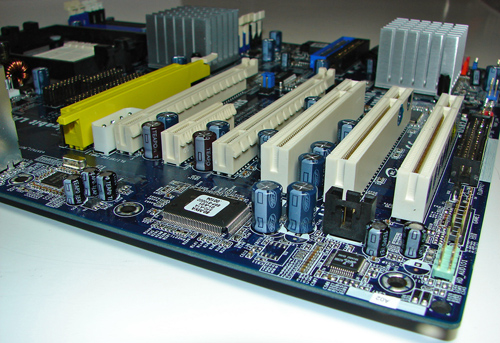
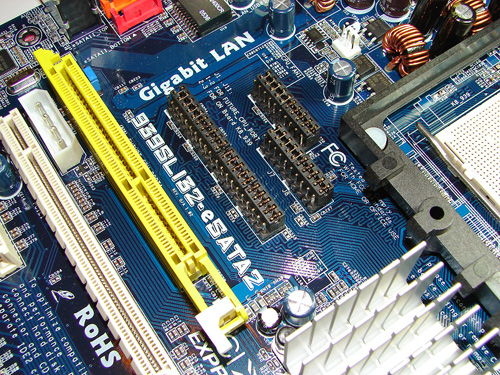
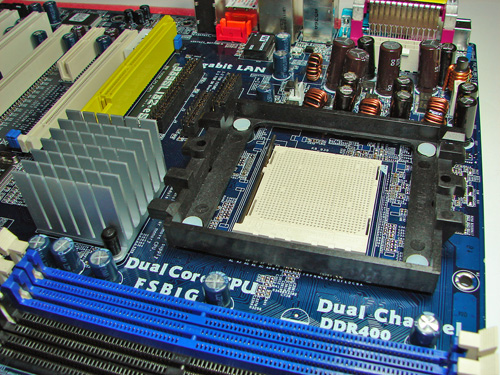
The ULI M1695 chipset is passively cooled with a large heat sink unit that did not interfere with any installed peripherals. However, this unit did not keep the M1695 chipset cooled properly. We typically witnessed temperatures hovering near 59c from this heat sink, although we did not notice any stability issues during load operations. We do believe additional cooling in this area is required.
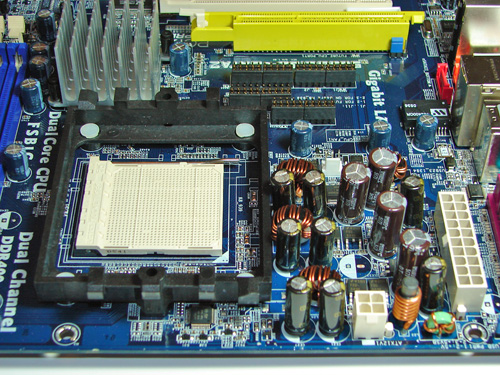
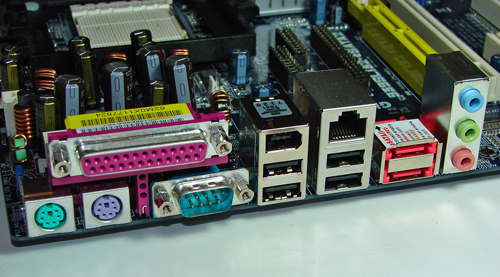










46 Comments
View All Comments
chesss - Tuesday, March 7, 2006 - link
hmm I was hoping for a more definite answer from anandtech about this. Anybody else?Gary Key - Tuesday, March 7, 2006 - link
What type of information are you looking for at this time? We have seen prototype AM2 daughter cards but have not been able to test a card yet due to ongoing engineering changes. Although the daughter card will have direct HT access through the M1695 chipset, we have to wonder how well ASRock will be able to optimize the DDR2 memory performance. The daughter card will also limit cooling options available for the CPU choice. The other variable will be cost and if you are upgrading to AM2 then the additional cost of a motherboard in this category should not be an issue. When all is said and done we still think this is a marketing driven feature and not a viable engineering solution for most users.itroxx - Wednesday, March 8, 2006 - link
Hello everybody,I'am also looking for a new system for mainly video editing. Working with Premiere, MPEG2 encoding and DVD authoring. Thats why I found this review cause the AsRock seems the only board available with SATA2-Raid capabilities right now. But I am not sure about how much SATA2 drives can be attached. Is it possible to attach one SATA2 drive for the system and build a Raid0 of two more SATA2 drives? For what reason are the SATA connector on the rear panel?
The components I've selected at this point are
AMD Athlon64 X2 3800+ 2x2000MHz 2x512kB Box E4-Stepping
Asrock 939SLI32-eSATA2 S939 ATX
2x 1024 Corsair DDR400
1x Samsung 80GB SATA2 (System)
2x Samsung 250GB SATA2 (Raid0)
256MB PCIe x16 ATI RADEON X1300 PRO
What do you think of my selection? What type of power suply do I need?
Is 400 Watt enough?
thanks a lot and greetings from germany
Daniel
Redrider - Thursday, March 9, 2006 - link
Although my expertise is much lower than most of the people on this forum, there are a few things I have gleaned from my experience and research. Here are a couple of suggestion:You want the best you can get for the money you spend so as for the processor (I am seriously considering an X2 3800+ myself) I would go for the http://www.amdcompare.com/us-en/desktop/details.as...">ADA3800DAA5CD
which has the E6 stepping which is a newer revision based on http://www.techpowerup.com/articles/overclocking/2...">this article
Also, I would boost your power supply. You are spending some serious cash and I don't think skimping on the PS is wise. 400W seems pretty small and I would go with big power overhead just to be sure.
UJMA - Saturday, March 4, 2006 - link
The people who invariably buy SLi enabled boards are gamers, and gamers love to OVERCLOCK! unfortunately Asrock have provided this board with a feeble set of voltage options, both the Vdimm & Vcore voltage options are pathetic. No problem, if you're handy with a soldering iron as I'm pretty sure some voltage mods will eventually show up for entusiasts. Probably a better option would be to wait for Epox to launch their new EP-9U1697 GLI mobo based on the same ULi M1697 chipset, you'll get SLi with better overclocking options for a similar outlay!Gary Key - Saturday, March 4, 2006 - link
We just happen to have that board available for testing now. :)
UJMA - Friday, March 24, 2006 - link
2 great reviews on boards using the ULi M1697 chipset. In the red corner we have the Asrock 939SLI32-eSATA2, in the blue corner we have the EPoX EP-9U1697-GLi ... I'm going for the Epox board.Wesley Fink - Saturday, March 4, 2006 - link
Keep in mind the Epox is dual x8 using a single M1697 chipset, while the ASROCK is an amazing dual x16. If dual x8 is enough for you though, the Epox should be an interesting board.UJMA - Saturday, March 4, 2006 - link
I was looking at the Epopx website specs ..."Two PCI Express (x16) connector compliant with PCI Express 1.0a"
http://www.epox.com.tw/eng/products_content.php?ps...">http://www.epox.com.tw/eng/products_content.php?ps...
Gary Key - Saturday, March 4, 2006 - link
There are two physical x16 connectors on the Epox board but they are electrically x8 lanes in SLI mode. The ASRock 939SLI32 has the same physical x16 connectors but electrically they are x16 lanes in SLI mode.